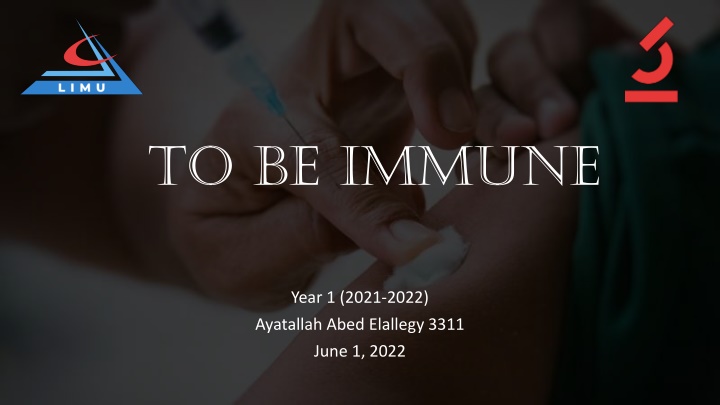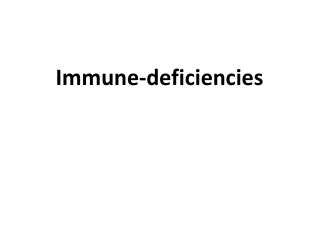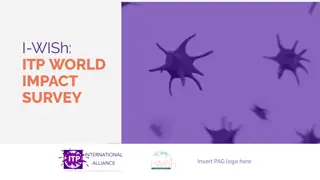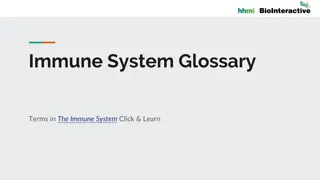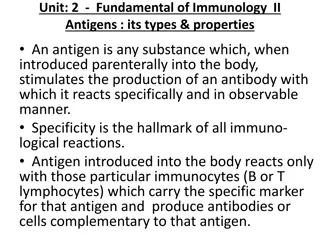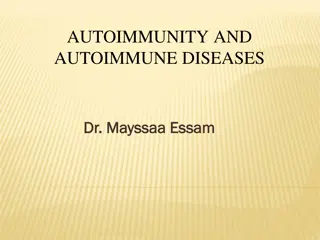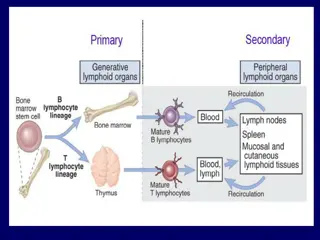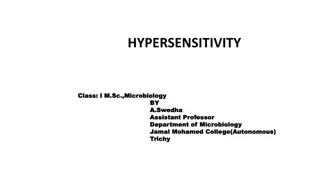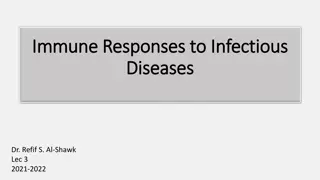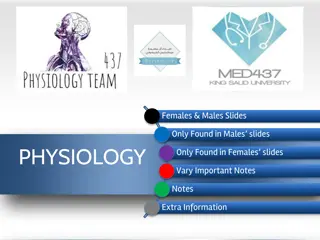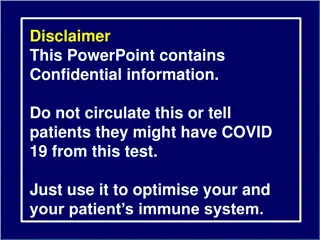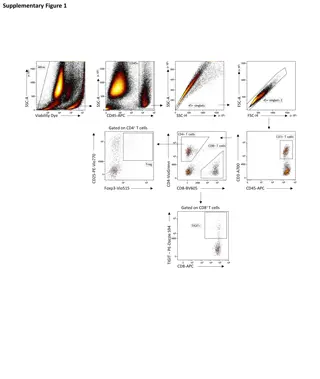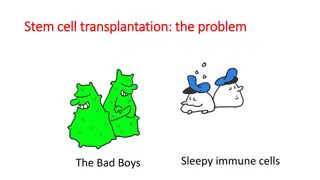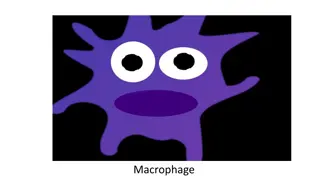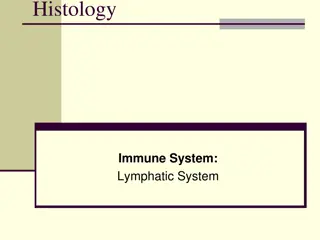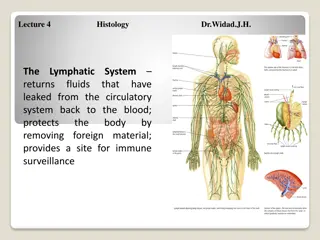To be Immune
Immunization and vaccines play a crucial role in safeguarding public health by creating immunity against diseases. Explore the importance of immunization, how vaccines work, different types of vaccines, and the significance of vaccine tracking and development processes. Dive into the world of immunization and its impact on global health.
Download Presentation

Please find below an Image/Link to download the presentation.
The content on the website is provided AS IS for your information and personal use only. It may not be sold, licensed, or shared on other websites without obtaining consent from the author.If you encounter any issues during the download, it is possible that the publisher has removed the file from their server.
You are allowed to download the files provided on this website for personal or commercial use, subject to the condition that they are used lawfully. All files are the property of their respective owners.
The content on the website is provided AS IS for your information and personal use only. It may not be sold, licensed, or shared on other websites without obtaining consent from the author.
E N D
Presentation Transcript
To be Immune Year 1 (2021-2022) Ayatallah Abed Elallegy 3311 June 1, 2022
Introduction Introduction Why is it important to be immunized?
Objectives Differentiate between vaccination & immunization Outline how vaccines work Discuss the types of vaccines Outline the importance of vaccine tracking Discuss the development process of vaccines List the protocol of vaccines
Immunization Vs Vaccine Immunization is a process that makes a person protected or immune against a A vaccine reduces risks of getting a disease by working with your body s natural defense system and stimulates the body s immune disease or infection through vaccination The 2 public health interventions that have had the greatest impact on the world s health are clean water and vaccines - The World Health Organization response against diseases by administering antigenic material. 1
How a Vaccine Works 1. An infection is when germs and bacteria invade, multiply, attack and cause illness 2. Vaccines are artificial infections that causes illness while felicitating T-cell stimulation and antibody production 3. Develop normal and expected symptoms such as fever, sore arms and headaches that are due to the vaccine not having enough time to provide protection. 4. After the artificial infection goes away and a week has passed, you're left with developed B-cells and memory T-Cells that protect you from getting that same infection in the future 2
Types of Vaccines Inactive Live Subunit Toxoid 3
Vaccine Tracking Ensures that the recommended vaccine is received Precludes forgetting the date and type of vaccine you were given. Keeps you informed of new and upcoming vaccines If you move or travel it makes it a lot easier for your next GP Ensures vaccinated patients do not receive the same vaccine twice . A- Helps control the cost of the drug B- Decrease the number of adverse reactions to vaccines 4
1. Exploratory stage 2. Pre-clinical stage Development 3. Clinical development 4. Regulatory review and approval 5. Manufacturing 6. Quality control 5
Vaccines Administration Protocol 1. Review immunization history 2. Assess for needle immunization 3. Screen for contraindications and precautions 4. Educate the patient 5. Prepare the vaccine 6. Administer the vaccine 7. Document the vaccine 6 This Photo by Unknown Author is licensed under CC BY-ND
Conclusion Conclusion Why is it important to be immunized? - Saved 2 to 3 million children each year from deadly diseases. - Doesn t discriminate against age, ethnicity or sex. - Decrease the chance for diseases to spread and return. - Keeps people who can t be vaccinated safe - We should all be grateful for the healthcare providers who put themselves in danger to keep us and our loved ones safe. 7
References 1. [Internet]. 2022 [cited 31 May 2022]. Available from: https://www.fraserhealth.ca/health-topics-a-to- 2. What Is Immunization? | immunizecanada [Internet]. Immunize.ca. 2022 [cited 31 May 2022]. Available from: https://immunize.ca/what-immunization 3. [Internet]. 2022 [cited 31 May 2022]. Available from: https://www.cdc.gov/vaccines/vac-gen/imz- basics.htm 4. [Internet]. Cpha.ca. 2022 [cited 31 May 2022]. Available from: https://www.cpha.ca/sites/default/files/assets/policy/immun_e.pdf 5. Adults [Internet]. Immunize BC. 2022 [cited 31 May 2022]. Available from: https://immunizebc.ca/adults 6. Five important reasons to vaccinate [Internet]. Immunize BC. 2022 [cited 31 May 2022]. Available from: https://immunizebc.ca/reasons-to-vaccinate 7. [Internet]. 2022 [cited 31 May 2022]. Available from: https://www.canada.ca/en/public- health/services/publications/healthy-living/parent-guide-vaccination.html 8. [Internet]. 2022 [cited 31 May 2022]. Available from: https://www.cdc.gov/vaccines/vac-gen/imz- basics.htm 9. How do vaccines work? [Internet]. Who.int. 2022 [cited 31 May 2022]. Available from: https://www.who.int/news-room/feature-stories/detail/how-do-vaccines-work
10. [Internet]. 2022 [cited 31 May 2022]. Available from: https://www.hhs.gov/immunization/basics/types/index.html 11. Types of vaccine | Vaccine Knowledge [Internet]. Vk.ovg.ox.ac.uk. 2022 [cited 31 May 2022]. Available from: https://vk.ovg.ox.ac.uk/vk/types-of-vaccine 12. [Internet]. 2022 [cited 31 May 2022]. Available from: https://www.cdc.gov/vaccines/hcp/acip- recs/general-recs/index.html 13. [Internet]. 2022 [cited 31 May 2022]. Available from: https://www.cdc.gov/vaccines/programs/vtrcks/index.html 14. [Internet]. 2022 [cited 31 May 2022]. Available from: https://www.cdc.gov/vaccines/basics/test- approve.html
